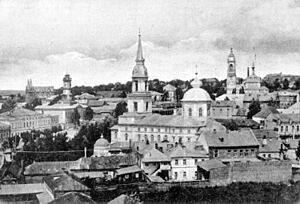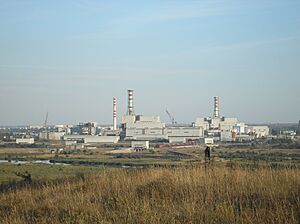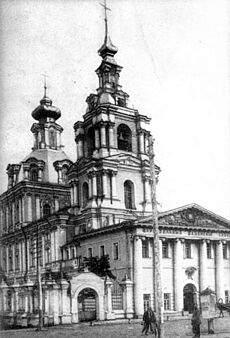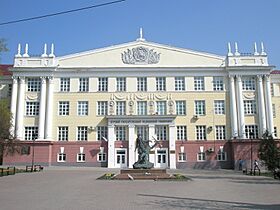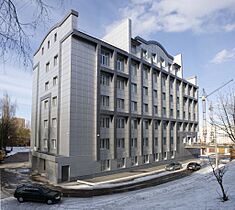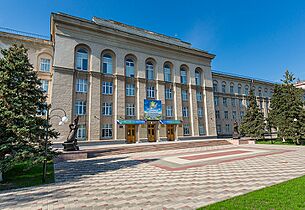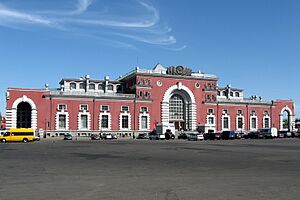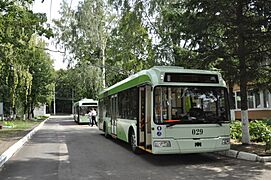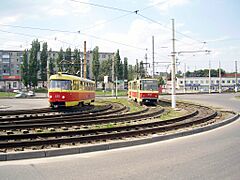Kursk facts for kids
Quick facts for kids Kursk (English)Курск (Russian) |
|
|---|---|
| - City - | |
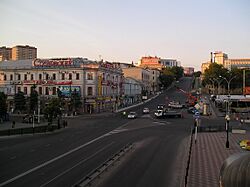 Kursk street view |
|
|
|
|
| City Day | September 25 |
| Administrative status | |
| Country | Russia |
| Federal subject | Kursk Oblast |
| Administratively subordinated to | city of oblast significance of Kursk |
| Municipal status | |
| Urban okrug | Kursk Urban Okrug |
| Head | Alexander Zakurdayev |
| Representative body | Kursk City Assembly (Russian: Курское городское Собрание) |
| Statistics | |
| Area | 188.75 km2 (72.88 sq mi) |
| Population (2010 Census, preliminary) |
415,159 inhabitants |
| - Rank in 2010 | 42nd |
| Density | 2,200/km2 (5,698/sq mi) |
| Time zone | MSK (UTC+04:00) |
| First mentioned | 1032 |
| City status since | 1779 |
| Postal code(s) | 305000 |
| Dialing code(s) | +7 4712 |
| [kurskadmin.ru Official website] | |
Kursk (Russian: Курск) is a city in Russia. It is the main city of Kursk Oblast. Kursk is located where the Kur, Tuskar, and Seym rivers meet. In 2021, about 440,052 people lived there.
The area around Kursk was very important during World War II. It was the site of the Battle of Kursk, which was one of the largest battles in history. This battle was a major turning point in the war between the Soviet Union and Germany.
Contents
Geography
How Kursk is laid out
Kursk was first built as a strong fortress city on a hill. Rivers like the Kur and Tuskar surrounded it on three sides. Forests were to the north, making it a naturally protected place. By 1603, Kursk became a key military and economic center.
The city's location was important because Crimean Tatars often crossed the Seym river nearby. Their main travel route, the Muravsky Trail, also passed east of the city. This made Kursk a vital fortress in the southern region. In 1616, about 1600 soldiers protected the city.
Over time, Kursk grew and changed. In 1782, the city was mostly made of wooden houses. Many streets were narrow. Later, a new plan for the city was made to organize its buildings and streets better. This plan aimed to create a more "ceremonial" look for the city center.
The city was divided into parts, and new government buildings were constructed. These included public offices, a hospital, and schools. The main streets, Moskovskaya and Khersonskaya (now Lenin and Dzerzhinsky), met at Red Square. This plan guided Kursk's development for about 150 years.
Kursk's climate
Kursk has a climate with warm summers and cold, snowy winters. The average temperature in January is around -5.9°C (21.4°F). In July, the average temperature is about 20.3°C (68.5°F). The city gets a good amount of rain throughout the year, with more in summer. Snowfall is common in winter months.
| Climate data for Kursk (1991–2020, extremes 1833–present) | |||||||||||||
|---|---|---|---|---|---|---|---|---|---|---|---|---|---|
| Month | Jan | Feb | Mar | Apr | May | Jun | Jul | Aug | Sep | Oct | Nov | Dec | Year |
| Record high °C (°F) | 8.5 (47.3) |
9.5 (49.1) |
22.5 (72.5) |
28.1 (82.6) |
32.6 (90.7) |
36.5 (97.7) |
37.2 (99.0) |
38.8 (101.8) |
33.0 (91.4) |
26.8 (80.2) |
17.7 (63.9) |
10.2 (50.4) |
38.8 (101.8) |
| Mean daily maximum °C (°F) | −3.5 (25.7) |
−2.6 (27.3) |
3.1 (37.6) |
12.9 (55.2) |
20.0 (68.0) |
23.5 (74.3) |
25.5 (77.9) |
24.8 (76.6) |
18.3 (64.9) |
10.6 (51.1) |
2.5 (36.5) |
−2.1 (28.2) |
11.1 (52.0) |
| Daily mean °C (°F) | −5.9 (21.4) |
−5.5 (22.1) |
−0.3 (31.5) |
8.2 (46.8) |
14.8 (58.6) |
18.4 (65.1) |
20.3 (68.5) |
19.4 (66.9) |
13.5 (56.3) |
6.9 (44.4) |
0.1 (32.2) |
−4.3 (24.3) |
7.1 (44.8) |
| Mean daily minimum °C (°F) | −8.3 (17.1) |
−8.2 (17.2) |
−3.4 (25.9) |
3.9 (39.0) |
9.8 (49.6) |
13.5 (56.3) |
15.4 (59.7) |
14.4 (57.9) |
9.3 (48.7) |
3.8 (38.8) |
−2.0 (28.4) |
−6.6 (20.1) |
3.5 (38.3) |
| Record low °C (°F) | −34.5 (−30.1) |
−35.3 (−31.5) |
−32.6 (−26.7) |
−15.6 (3.9) |
−6.1 (21.0) |
0.4 (32.7) |
6.1 (43.0) |
1.9 (35.4) |
−3.9 (25.0) |
−17.4 (0.7) |
−25.0 (−13.0) |
−32.7 (−26.9) |
−35.3 (−31.5) |
| Average precipitation mm (inches) | 47 (1.9) |
41 (1.6) |
45 (1.8) |
41 (1.6) |
56 (2.2) |
65 (2.6) |
78 (3.1) |
47 (1.9) |
63 (2.5) |
58 (2.3) |
44 (1.7) |
47 (1.9) |
632 (24.9) |
| Average extreme snow depth cm (inches) | 14 (5.5) |
20 (7.9) |
15 (5.9) |
1 (0.4) |
0 (0) |
0 (0) |
0 (0) |
0 (0) |
0 (0) |
0 (0) |
2 (0.8) |
7 (2.8) |
20 (7.9) |
| Average rainy days | 9 | 8 | 9 | 15 | 16 | 17 | 17 | 13 | 16 | 16 | 14 | 11 | 161 |
| Average snowy days | 23 | 21 | 15 | 4 | 0.4 | 0 | 0 | 0 | 0.4 | 3 | 13 | 22 | 102 |
| Average relative humidity (%) | 86 | 83 | 78 | 66 | 61 | 68 | 69 | 67 | 74 | 80 | 87 | 87 | 76 |
| Mean monthly sunshine hours | 46.9 | 74.0 | 144.5 | 204.2 | 286.2 | 316.5 | 314.7 | 287.0 | 188.4 | 113.4 | 59.6 | 31.4 | 2,066.8 |
| Source 1: Pogoda.ru.net | |||||||||||||
| Source 2: NOAA | |||||||||||||
History
Early history of Kursk
The first time Kursk was mentioned in writing was in 1032. It was part of a region called Severia. Prince Igor talked about Kursk in an old story called The Tale of Igor's Campaign. He described the people of Kursk as brave knights, ready for battle.
In the 12th and 13th centuries, the city was attacked by the Turkic-speaking Polovtsians. Around 1237, the Mongols led by Batu Khan destroyed Kursk. But the city was rebuilt by 1283.
Between 1360 and 1508, Kursk was ruled by the Grand Duchy of Lithuania. In 1508, it became part of the centralized Russian state. It served as an important border city in the south.
Kursk in modern times
A new fortress was built in Kursk in 1596. It had over 1,300 soldiers by 1616. In the early 17th century, Kursk faced many attacks. Forces from the Polish–Lithuanian Commonwealth tried to take it several times. The Crimean Khanate and Nogai Horde also launched raids. However, the Kursk fortress was never captured.
Kursk grew because of its good location. It was on the shortest route from Moscow to Crimea and Kiev. This made it a key center for trading grain with Ukraine. A big fair was held there every year.
During the Russian Empire, Kursk changed administrative regions several times. It finally became the main city of Kursk Governorate in 1797. After a big fire in 1781, a new city plan was made. This plan put a market in the central square, now called Red Square.
The city also developed its education. The first school for nobility opened in 1783. A school for boys opened in 1808, and one for girls in 1872.
Kursk in the 20th century
In the early 1900s, Kursk was important for food production. It had large breweries and factories that processed grain. Some of these products were even sent to other countries. There were also several engineering businesses. Working conditions were often tough, leading to worker strikes.
After the October Revolution in Russia, the Soviets took control of Kursk in late 1917. During the Russian Civil War, the city was taken by anti-Bolshevik troops in 1919. But the Red Army soon took it back.

The Soviet government saw Kursk as important because of its rich iron ore deposits. They also made it a major railroad hub in southwestern Russia. In 1935, Kursk got its first tram system. The city was divided into different districts.
During World War II, German forces occupied Kursk from November 1941 to February 1943. In July 1943, the Germans tried to recapture Kursk in Operation Citadel. This led to the Battle of Kursk, which included the Battle of Prokhorovka. This was one of the largest tank battles ever. The Soviet victory here was a major turning point on the Eastern Front.
After the war, rebuilding efforts began quickly in February 1944. Cinemas and theaters reopened. By 1950, the city's economy was fully restored. The tram system started running again in 1953.
Recent history of Kursk
In 2009, a very important religious icon, Theotokos of Kursk, was brought back to the city. It is highly respected in the Russian Orthodox Church.
In 2012, Kursk celebrated its 980th anniversary. The city continues to develop its services, like opening new firehouses with modern equipment.
Administration and local government
Kursk is the main administrative center for the Kursk Oblast region. It also serves as the administrative center for Kursky District. However, Kursk itself is not part of Kursky District. Instead, it is set up as its own special administrative unit called the city of oblast significance of Kursk.
For local government, the city of oblast significance of Kursk is known as the Kursk Urban Okrug. This means it has its own city government that manages its affairs.
Economy and infrastructure
Kursk is an important industrial city. Its main industries include iron-based manufacturing, chemicals, and a large food processing sector. This is because the surrounding "Black Earth" region has very rich farmland.
A special feature near Kursk is the Kursk Magnetic Anomaly. This is the world's largest known reserve of iron ore. The ore here has a very high iron content, from 35% to 60%.
About 40 kilometers (25 miles) southwest of Kursk, in Kurchatov, is the Kursk Nuclear Power Plant. It has four RBMK-1000 reactors. The oldest reactor started working in 1977.
Attractions and landmarks

The oldest building in Kursk is the upper church of the Trinity Monastery. It shows a special architectural style from the time of Peter the Great. The oldest non-religious building is the Romodanovsky Chamber, built in the mid-1700s.
The city's main cathedral was built between 1752 and 1778. It has a beautiful Baroque style. Many people thought the famous architect Bartolomeo Rastrelli designed it because it was so grand. It is one of the most impressive Baroque buildings not built for the royal family.
This cathedral has two levels. The lower church is for St. Sergius of Radonezh, and the upper one is for the Theotokos of Kazan. The upper church has a very detailed screen for icons that took 16 years to finish. The cathedral's bell tower is also famous. Seraphim of Sarov, a well-known saint, survived a fall from its top floor when he was seven years old. The Resurrection Church, where St. Seraphim was baptized, is also in Kursk.
The monastery cathedral of the Sign (1816–26) is another grand building. It is built in a pure Neoclassical style. Its dome is 20 meters (66 feet) wide and 48 meters (157 feet) high. During the Soviet era, parts of the cathedral were removed, but there are plans to restore it.
Kursk is home to several universities. These include Kursk State Medical University, State Technical University, and Kursk State University.
There are also modern memorials in Kursk. These remember the Battle of Kursk, both in the city and nearby Prokhorovka. The Command Station Bunker & Museum honors the brave Russian T-34 tank units from that battle. Over 6,000 armored vehicles fought near Kursk in 1943. This battle stopped the German advance and was a turning point in World War II.
Near Kursk, you can find the Tsentralno-Chernozemny Zapovednik. This is a large area of natural steppe soil that has never been plowed. It is used for scientific research.
Education
Transportation
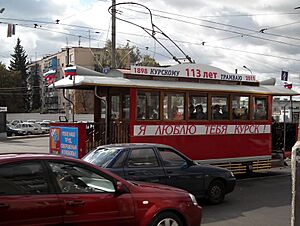
Kursk has been connected to Moscow by railway since 1868. It is on a major railway line that goes between Moscow and Kharkiv. Trains also connect Kursk to Voronezh and Kyiv. The Kursk Vostochny Airport offers flights within Russia.
Public transport in Kursk includes buses, trolleybuses, and trams. Since 2007, the public transport system uses a satellite navigation system. The city has a large network of paved roads, totaling almost 600 kilometers (370 miles). These roads connect Kursk to major highways like M2 "Crimea" and A144.
Intercity buses from Kursk travel to towns in the Kursk region and nearby areas. They also go to Moscow, St. Petersburg, and cities in Ukraine like Kharkiv and Sumy. The main bus station is in the northwest part of the city.
In 2011, Kursk started using an automated system for bus fares. This system helps manage tickets and social cards for public transport.
Culture and sports
Kursk State University is home to the Russian Chamber Orchestra. This orchestra performs often, tours internationally, and has released many CDs.
The Pushkin Theater is in the city center. It has its own group of actors and also hosts visiting shows.
In 2016, a new women's hockey team, Dynamo Kursk, joined the Russian Women's Hockey League.
The rock band Little Tragedies is originally from Kursk.
Media
People in Kursk with ham radios could watch television from Moscow starting in 1935. In 1960, a special committee for Radio and Television was created for the Kursk region. The first local TV broadcast aired on January 14, 1961. Today, major phone and internet companies operate in the city.
Honors
- A minor planet, 3073 Kursk, was discovered in 1979 by Soviet astronomer Nikolai Chernykh. It was named after the city.
- The Russian submarine Kursk was named after the city.
Notable people
Many famous people come from Kursk, including:
- Yekaterina Avdeyeva (1788–1865), a writer.
- Valery Chaplygin, an Olympic champion cyclist.
- Alexander Deyneka, a famous painter and sculptor.
- Kazimir Malevich, a well-known painter.
- Alexander Povetkin, an Olympic champion boxer.
- Seraphim of Sarov, a monk and saint.
- Mikhail Shchepkin, a famous actor.
- Georgy Sviridov, a composer.
- The Tolmachevy Twins, singers.
Twin towns – sister cities
Kursk has "twin town" or "sister city" relationships with other cities around the world. These partnerships help promote cultural exchange and friendship.
Kursk is twinned with:
Some cities have ended their partnerships with Kursk. For example, on March 8, 2022, the Polish city of Tczew ended its partnership with Kursk.
See also
 In Spanish: Kursk para niños
In Spanish: Kursk para niños



